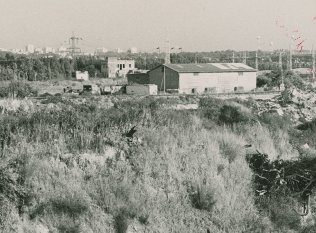| Year | Arab | Jews | Total |
|---|---|---|---|
| 1931 * | 305 | ||
| 1944/45 | 470 | 210 | 680 |
| Year | Arab | Jewish | Public | Total |
|---|---|---|---|---|
| 1944/45 | 8692 | 5980 | 535 | 15207 |
| Use | Arab | Jewish | Public | Total | ||||||||||||||||||||
|---|---|---|---|---|---|---|---|---|---|---|---|---|---|---|---|---|---|---|---|---|---|---|---|---|
|
597 | 1593 | 492 | 2682 (18%) | ||||||||||||||||||||
|
8095 | 4387 | 43 | 12525 (82%) |
The village stood on a hilltop, overlooking the Mediterranean coast to the west and a wide expanse of the coastal plain to the east. Ijill al-Qibliyya (southern Ijill) was approximately 100 m southwest of its twin village, Ijill al-Shamaliyya (northern Ijill). It was probably named after a Shaykh Salih 'Abd al-Jalil, whose tomb/shrine (maqam) was located on the site. Ijill al-Qibliyya dated to at least the end of the nineteenth century; it is marked on the map of the area made in 1881 by the authors of the Survey of Western Palestine. All of the residents at that time were Muslim. Their houses were made either of adobe brick or concrete, and were loosely grouped into three quarters, separated by vacant lots which were gradually filled in by new construction. Children went to school in ljIil al-Shamaliyya; students from both villages numbered about sixty-four in 1945. The sandy nature of the area's soil enabled villagers to cultivate fruits, especially citrus. In 1944/45 a total of 923 dunums was devoted to citrus and bananas and 7,087 dunums were allotted to cereals; 85 dunums were irrigated or used for orchards. In addition to agriculture, the residents engaged in fishing. About 1 km to the northwest lay Tall Makmish (131174), which was excavated between 1977 and 1980. The excavations revealed that the site had been occupied from the seventeenth century B.C. through the eighth century A.D., with four gaps indicating temporary abandonment.
According to the History of the Haganah, a meeting was held in Petach Tiqwa in late 1947 or early 1948 between Haganah representatives and the mukhtars of some surrounding villages, during which the latter 'expressed a desire for peace.' The mukhtar of IjIil was reportedly among them, but the meeting apparently did little to guarantee the village's safety. Israeli historian Benny Morris states that the villagers, fearing a Jewish attack, fled on 3 April 1948. The History of the Haganah claims that they left due to pressure from Arab militiamen. By this time, the whole area between Tel Aviv and Hertzeliyya had been emptied of its Arab inhabitants.
Much later in the war, IjIil became an internment camp for Arab prisoners captured by the Haganah. A New York Times correspondent reported on 11 October: 'About half of the 5,000 Arab prisoners captured by the Israeli Army since May are held in a tent camp hastily thrown up on the sand and scrub of a little valley beside this former Arab village.' The camp was located off the Tel Aviv–Haifa road, a few hundred yards from the sea, and included more than 200 large tents. The reporter wrote that 'not even the camp authorities are certain how many of [the prisoners actually were soldiers in the Arab armies.' All but 250 were Palestinians, picked up after their villages had been captured.
The site serves as a garbage dump and the original village can hardly be identified. On the thin swath of the hill that has not yet been covered with waste, remnants of stone houses stand next to a gasoline storage tank, along with bushes and cactuses. Approximately 100 m east of the tank a deserted house stands next to the remains of a razed building (see photos).



